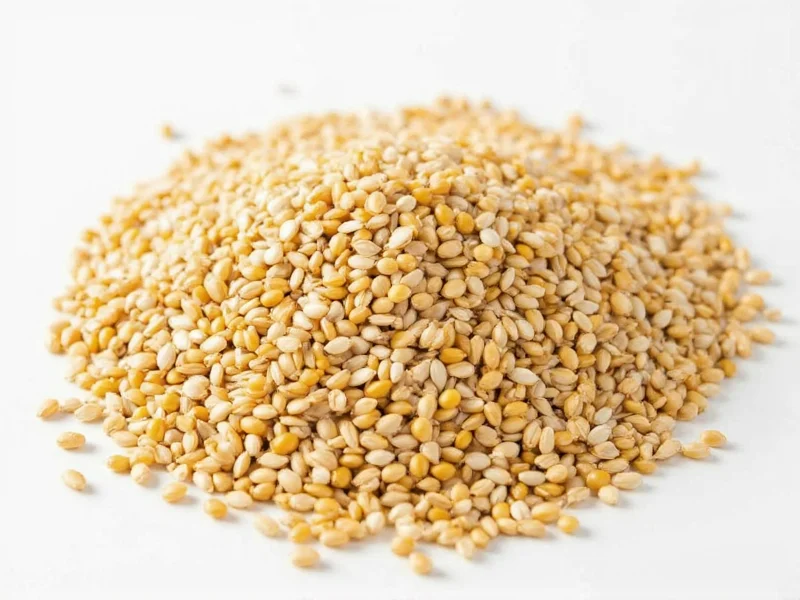Sesame seeds deliver a distinctive flavor experience that varies significantly based on preparation. Understanding their taste profile helps home cooks and professional chefs alike harness their full culinary potential. This comprehensive guide explores the nuanced flavor characteristics of sesame seeds, how preparation methods affect their taste, and why they've become a staple ingredient across global cuisines.
The Flavor Profile of Raw Sesame Seeds
Raw sesame seeds possess a relatively mild flavor compared to their toasted counterparts. They offer subtle earthy notes with a faint bitterness and minimal nuttiness. The taste remains delicate enough that they won't overpower other ingredients, making them suitable for applications where a gentle sesame presence is desired. White sesame seeds typically have a milder flavor than black sesame seeds, which contain more natural compounds that contribute to a slightly stronger taste.
How Toasting Transforms Sesame Flavor
When sesame seeds undergo toasting, a remarkable flavor transformation occurs through the Maillard reaction and caramelization. This chemical process develops complex flavor compounds that create the characteristic rich, nutty profile most people associate with sesame. Properly toasted sesame seeds develop warm, roasted notes reminiscent of peanuts or hazelnuts with a subtle underlying sweetness. Over-toasting can lead to bitterness, while under-toasting leaves the seeds with their mild raw flavor.
| Characteristic | Raw Sesame Seeds | Toasted Sesame Seeds |
|---|---|---|
| Primary Flavor Notes | Mild, slightly earthy, faint bitterness | Rich, nutty, roasted, subtle sweetness |
| Aroma Intensity | Subtle, barely noticeable | Strong, warm, inviting |
| Texture | Firm, slightly chewy | Crisp, more brittle |
| Aftertaste | Minimal, clean finish | Pleasant lingering nuttiness |
| Culinary Best Uses | Baking, raw applications, mild dressings | Finishing dishes, sauces, stir-fries, marinades |
The Science Behind Sesame's Nutty Flavor
The distinctive nutty flavor of toasted sesame seeds comes primarily from sesamol and sesamin compounds, along with various pyrazines formed during heating. These natural compounds create the warm, roasted notes that make sesame such a valuable flavor enhancer. Black sesame seeds contain additional anthocyanins that contribute to their slightly more complex flavor profile compared to white sesame seeds. The high oil content (approximately 50%) in sesame seeds also plays a crucial role in carrying and enhancing flavors in dishes.
Culinary Applications and Flavor Pairings
Chefs value sesame seeds for their ability to complement both savory and sweet preparations. In Asian cuisine, toasted sesame seeds feature prominently in dishes like gomaae (sesame spinach) and as garnishes for sushi and rice bowls. The nutty flavor pairs exceptionally well with garlic, ginger, soy sauce, and citrus. In Middle Eastern cooking, sesame seeds form the base of tahini, where their flavor transforms into a creamy, complex paste. Understanding what do sesame seeds taste like in recipes helps determine whether to use them raw, toasted, or processed into pastes.
Factors That Influence Sesame Seed Flavor
Several elements affect the final taste experience of sesame seeds:
- Freshness: Older seeds lose their delicate oils and develop rancidity
- Storage conditions: Exposure to light and heat accelerates flavor degradation
- Toast level: Precise control creates optimal flavor without bitterness
- Seed variety: White, black, and golden sesame seeds each have distinct profiles
- Processing method: Dry toasting versus oil toasting creates different flavor dimensions
How Sesame Flavor Compares to Other Seeds
When considering sesame seed taste compared to other seeds, notable differences emerge. Poppy seeds offer a more subtle, slightly sweet flavor with floral notes. Sunflower seeds provide a stronger, more pronounced nuttiness with higher oil content. Pumpkin seeds (pepitas) deliver a grassier, more vegetal flavor profile. Chia seeds remain relatively neutral until hydrated, when they develop mild earthy notes. The unique balance of nuttiness, oil content, and toasting response makes sesame seeds irreplaceable in many culinary applications.
Maximizing Sesame Flavor in Your Cooking
To get the most from sesame seeds' flavor profile, toast them properly in a dry skillet over medium-low heat until they turn golden brown and emit a nutty aroma—typically 2-4 minutes. Shake the pan frequently to prevent burning. For what is the flavor profile of sesame seeds in sauces and dressings, grinding toasted seeds creates tahini, which develops a creamier, more complex flavor than using whole seeds. When adding sesame to finished dishes, sprinkle toasted seeds on just before serving to preserve their crisp texture and aromatic qualities.
Understanding Regional Variations in Sesame Flavor
Different growing regions produce sesame seeds with subtle flavor variations. Ethiopian sesame often displays more pronounced nuttiness, while Indian varieties may have slightly earthier notes. The soil composition and climate where sesame grows affects the oil profile and, consequently, the flavor characteristics. This regional variation explains why how would you describe sesame seed taste might differ slightly depending on the source, though the fundamental nutty profile remains consistent across varieties.











 浙公网安备
33010002000092号
浙公网安备
33010002000092号 浙B2-20120091-4
浙B2-20120091-4